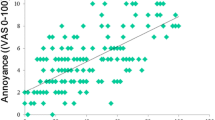Abstract
The aim was to determine the incidence of tinnitus, impaired hearing and musculoskeletal disorders among musicians and the relation to the number of practicing hours and/or the instrument type before the onset of symptoms. Method: The study base consisted of students enroled in the School of Music and Music Education at Göteborg University between the years 1980 and 1995. There were 407 of the 602 original students that answered a questionnaire (response rate of 68%). The questionnaire concerned exposure before and after the enrolment in the Music Academy, as well as onset of symptoms. Results: The highest incidence of symptoms was found for reported tinnitus with a rate of 10.6 per 1000 years of instrumental practice. There was a relationship between exposure to the number of hours of instrumental practice and incidence of impaired hearing. Among the musculoskeletal symptoms the highest incidences per 1000 years of instrumental practice were pain in the neck and in the left shoulder with a rate of 4.4 and 4.6 disorders per 1000 years of instrumental practice, respectively. There was 2.4 times higher incidence for musculoskeletal disorders in the right hand/wrist and a 2.2 times higher incidence in the left elbow/forearm for musicians who practiced for 20 h or more per week before the onset of disorders compared to those who practiced fewer than 20 h per week when controlling for age and gender. Musicians with a violin or a viola as the main instrument had four times the incidence for right elbow/forearm disorder and twice the incidence of neck pain, pain in the right shoulder and the left elbow/forearm compared to those who had piano as the main instrument.



Similar content being viewed by others
References
Altman DG, Machin D, Brayant T, Gardner MJ (2000) Statistics with confidence, 2nd edn. BMJ Books, pp 1–240
Axelsson A, Eliasson A, Israelsson B (1995) Hearing in pop/rock musicians: a follow-up study. Ear Hear 16:245–253
Bejjani FJ, Kaye G, MBenham M (1996) Musculoskeletal and neuromuscular conditions of instrumental musicians. Arch Phys Med Rehabil 77:406–413
Cayea D, Manchester RA (1998) Instrument-specific rates of upper extremity injuries in music students. Med Probl Perform Art 13:19–25
Collett D (1994) Modelling survival data in medical research. Chapman& Hall, New York, pp 1–347
Fjellman-Wiklund A, Sundelin G (1998) Musculoskeletal discomfort of music teachers: an eight-year perspective and psychosocial work factors. Int J Occup Environ Health 4:89–98
Gunderson E, Moline J, Catalano P (1997) Risks of developing noise-induced hearing loss in employees of urban music clubs. Am J Ind Med 31:75–79
Kähäri K, Zachau G, Eklof M, Sandsjo L, Moller C (2003) Assessment of hearing and hearing disorders in rock/jazz musicians. Int J Audiol 42:279–288
Laitinen HM, Toppila EM, Olkinuora PS, Kuisma K (2003) Sound exposure among the Finnish National Opera personnel. Appl Occup Environ Hyg 18:177–182
Lockwood AH (1989) Medical problems of musicians. N Engl J Med 320:221–227
Palin SL (1994) Does classical music damage the hearing of musicians? A review of the literature. Occup Med (Lond) 44:130–136
Rothman J (2002) Epidemiology: an introduction. Oxford University Press, Oxford, pp 1–223
Tornqvist EW, Kilbom A, Vingard E, Alfredsson L, Hagberg M, Theorell T, Waldenstrom M, Wiktorin C, Hogstedt C (2001) The influence on seeking care because of neck and shoulder disorders from work-related exposures. Epidemiology 12:537–545
Turner-Stokes L, Reid K (1999) Three-dimensional motion analysis of upper limb movement in the bowing arm of string-playing musicians. Clin Biomech (Bristol, Avon) 14:426–433
Zaza C (1998) Playing-related musculoskeletal disorders in musicians: a systematic review of incidence and prevalence. Cmaj 158:1019–1025
Zaza C, Farewell VT (1997) Musicians’ playing-related musculoskeletal disorders: an examination of risk factors. Am J Ind Med 32:292–300
Zetterberg C, Backlund H, Karlsson J, Werner H, Olsson L (1998) Musculoskeletal problems among male and female music students. Med Probl Perform Art 13:160–166
Acknowledgements
The development of the questionnaire was skillfully assisted by ergonomist Eva Ljungkvist and assistant professor Lisbeth Vecchi and dr Lars Olsson. Statistical computations were done by Catarina Karlberg. Skilful manuscript editing and typing Gunnel Garsell. Financial support came from Swedish council for working life and social research.
Author information
Authors and Affiliations
Corresponding author
Rights and permissions
About this article
Cite this article
Hagberg, M., Thiringer, G. & Brandström, L. Incidence of tinnitus, impaired hearing and musculoskeletal disorders among students enroled in academic music education—a retrospective cohort study. Int Arch Occup Environ Health 78, 575–583 (2005). https://doi.org/10.1007/s00420-005-0621-y
Received:
Accepted:
Published:
Issue Date:
DOI: https://doi.org/10.1007/s00420-005-0621-y




